Management Accounting Report: Cost Analysis for Jeffrey & Sons
VerifiedAdded on 2020/01/28
|18
|4731
|226
Report
AI Summary
This report focuses on management accounting principles, specifically examining cost information for budgeting and forecasting within Jeffrey and Son's, a manufacturing organization. The report covers various cost classifications (element, function, nature, behavior), job costing, and overhead absorption rates. It includes a job cost sheet for a specific job and analyzes overhead allocation methods, comparing machine hour and labor hour bases. Furthermore, the report presents a variance analysis comparing budgeted and actual costs, assessing performance indicators such as sales and profitability, and suggests cost reduction strategies, including technology adoption and efficient resource utilization. The analysis aims to provide insights into effective decision-making and performance improvement within the company.
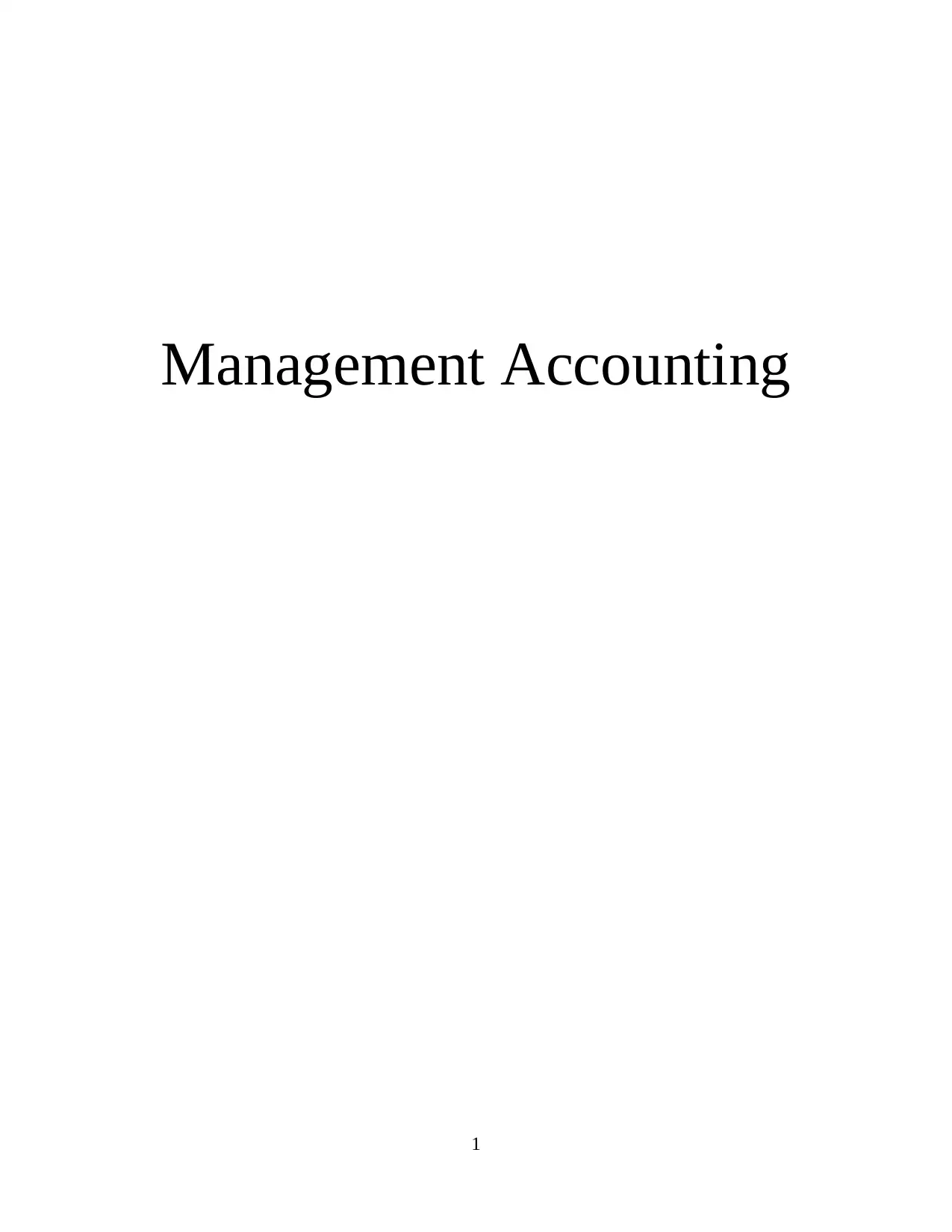
Management Accounting
1
1
Paraphrase This Document
Need a fresh take? Get an instant paraphrase of this document with our AI Paraphraser
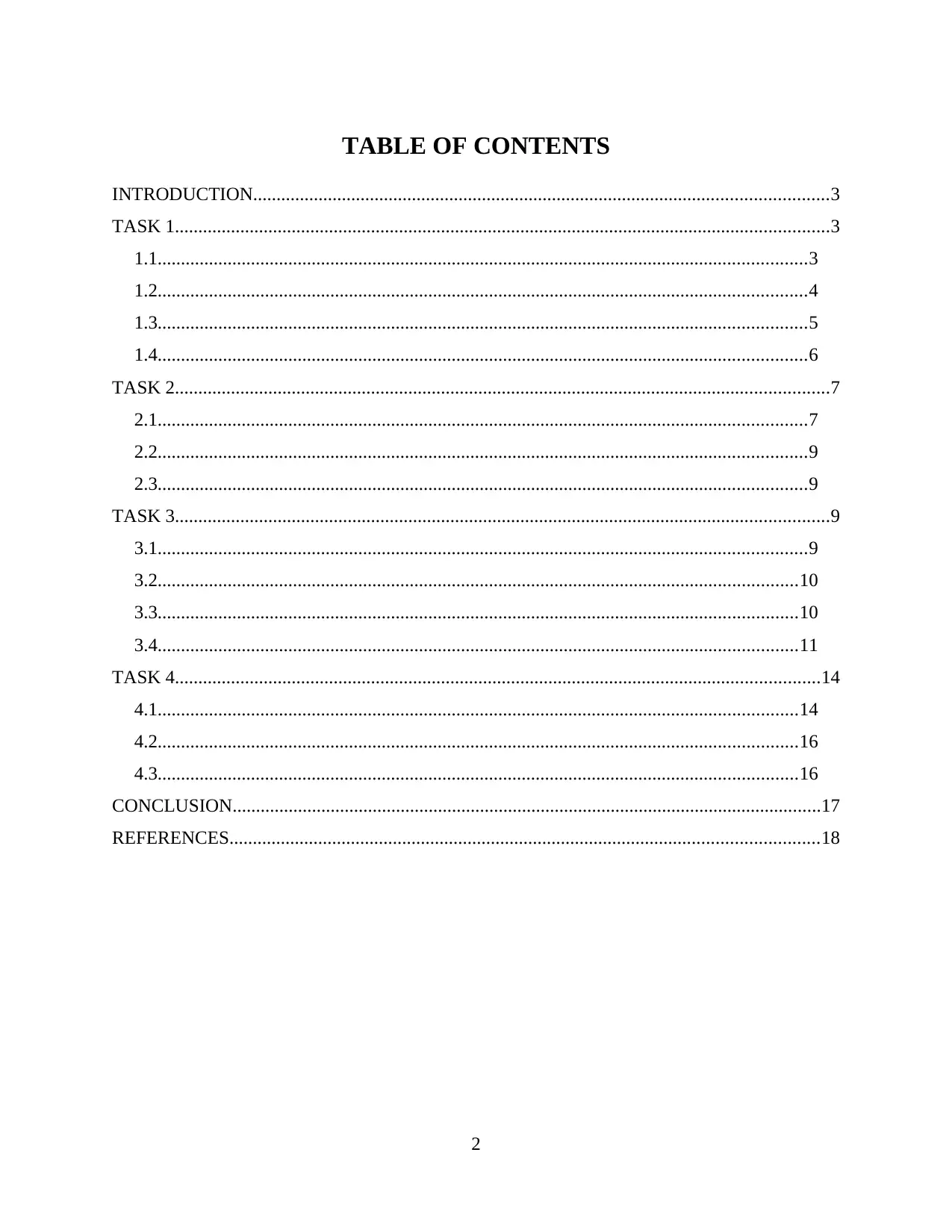
TABLE OF CONTENTS
INTRODUCTION...........................................................................................................................3
TASK 1............................................................................................................................................3
1.1...........................................................................................................................................3
1.2...........................................................................................................................................4
1.3...........................................................................................................................................5
1.4...........................................................................................................................................6
TASK 2............................................................................................................................................7
2.1...........................................................................................................................................7
2.2...........................................................................................................................................9
2.3...........................................................................................................................................9
TASK 3............................................................................................................................................9
3.1...........................................................................................................................................9
3.2.........................................................................................................................................10
3.3.........................................................................................................................................10
3.4.........................................................................................................................................11
TASK 4..........................................................................................................................................14
4.1.........................................................................................................................................14
4.2.........................................................................................................................................16
4.3.........................................................................................................................................16
CONCLUSION..............................................................................................................................17
REFERENCES..............................................................................................................................18
2
INTRODUCTION...........................................................................................................................3
TASK 1............................................................................................................................................3
1.1...........................................................................................................................................3
1.2...........................................................................................................................................4
1.3...........................................................................................................................................5
1.4...........................................................................................................................................6
TASK 2............................................................................................................................................7
2.1...........................................................................................................................................7
2.2...........................................................................................................................................9
2.3...........................................................................................................................................9
TASK 3............................................................................................................................................9
3.1...........................................................................................................................................9
3.2.........................................................................................................................................10
3.3.........................................................................................................................................10
3.4.........................................................................................................................................11
TASK 4..........................................................................................................................................14
4.1.........................................................................................................................................14
4.2.........................................................................................................................................16
4.3.........................................................................................................................................16
CONCLUSION..............................................................................................................................17
REFERENCES..............................................................................................................................18
2
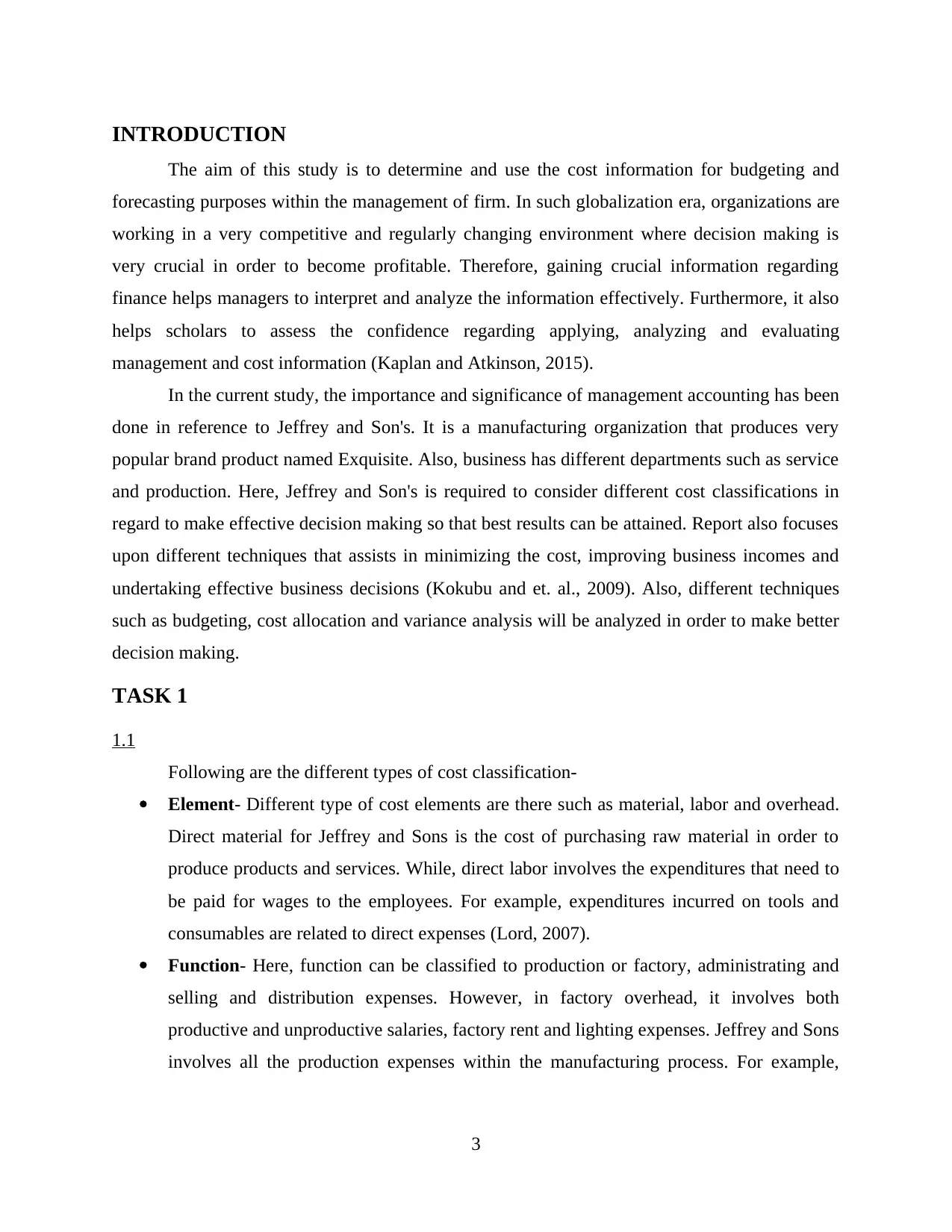
INTRODUCTION
The aim of this study is to determine and use the cost information for budgeting and
forecasting purposes within the management of firm. In such globalization era, organizations are
working in a very competitive and regularly changing environment where decision making is
very crucial in order to become profitable. Therefore, gaining crucial information regarding
finance helps managers to interpret and analyze the information effectively. Furthermore, it also
helps scholars to assess the confidence regarding applying, analyzing and evaluating
management and cost information (Kaplan and Atkinson, 2015).
In the current study, the importance and significance of management accounting has been
done in reference to Jeffrey and Son's. It is a manufacturing organization that produces very
popular brand product named Exquisite. Also, business has different departments such as service
and production. Here, Jeffrey and Son's is required to consider different cost classifications in
regard to make effective decision making so that best results can be attained. Report also focuses
upon different techniques that assists in minimizing the cost, improving business incomes and
undertaking effective business decisions (Kokubu and et. al., 2009). Also, different techniques
such as budgeting, cost allocation and variance analysis will be analyzed in order to make better
decision making.
TASK 1
1.1
Following are the different types of cost classification-
Element- Different type of cost elements are there such as material, labor and overhead.
Direct material for Jeffrey and Sons is the cost of purchasing raw material in order to
produce products and services. While, direct labor involves the expenditures that need to
be paid for wages to the employees. For example, expenditures incurred on tools and
consumables are related to direct expenses (Lord, 2007).
Function- Here, function can be classified to production or factory, administrating and
selling and distribution expenses. However, in factory overhead, it involves both
productive and unproductive salaries, factory rent and lighting expenses. Jeffrey and Sons
involves all the production expenses within the manufacturing process. For example,
3
The aim of this study is to determine and use the cost information for budgeting and
forecasting purposes within the management of firm. In such globalization era, organizations are
working in a very competitive and regularly changing environment where decision making is
very crucial in order to become profitable. Therefore, gaining crucial information regarding
finance helps managers to interpret and analyze the information effectively. Furthermore, it also
helps scholars to assess the confidence regarding applying, analyzing and evaluating
management and cost information (Kaplan and Atkinson, 2015).
In the current study, the importance and significance of management accounting has been
done in reference to Jeffrey and Son's. It is a manufacturing organization that produces very
popular brand product named Exquisite. Also, business has different departments such as service
and production. Here, Jeffrey and Son's is required to consider different cost classifications in
regard to make effective decision making so that best results can be attained. Report also focuses
upon different techniques that assists in minimizing the cost, improving business incomes and
undertaking effective business decisions (Kokubu and et. al., 2009). Also, different techniques
such as budgeting, cost allocation and variance analysis will be analyzed in order to make better
decision making.
TASK 1
1.1
Following are the different types of cost classification-
Element- Different type of cost elements are there such as material, labor and overhead.
Direct material for Jeffrey and Sons is the cost of purchasing raw material in order to
produce products and services. While, direct labor involves the expenditures that need to
be paid for wages to the employees. For example, expenditures incurred on tools and
consumables are related to direct expenses (Lord, 2007).
Function- Here, function can be classified to production or factory, administrating and
selling and distribution expenses. However, in factory overhead, it involves both
productive and unproductive salaries, factory rent and lighting expenses. Jeffrey and Sons
involves all the production expenses within the manufacturing process. For example,
3
⊘ This is a preview!⊘
Do you want full access?
Subscribe today to unlock all pages.

Trusted by 1+ million students worldwide
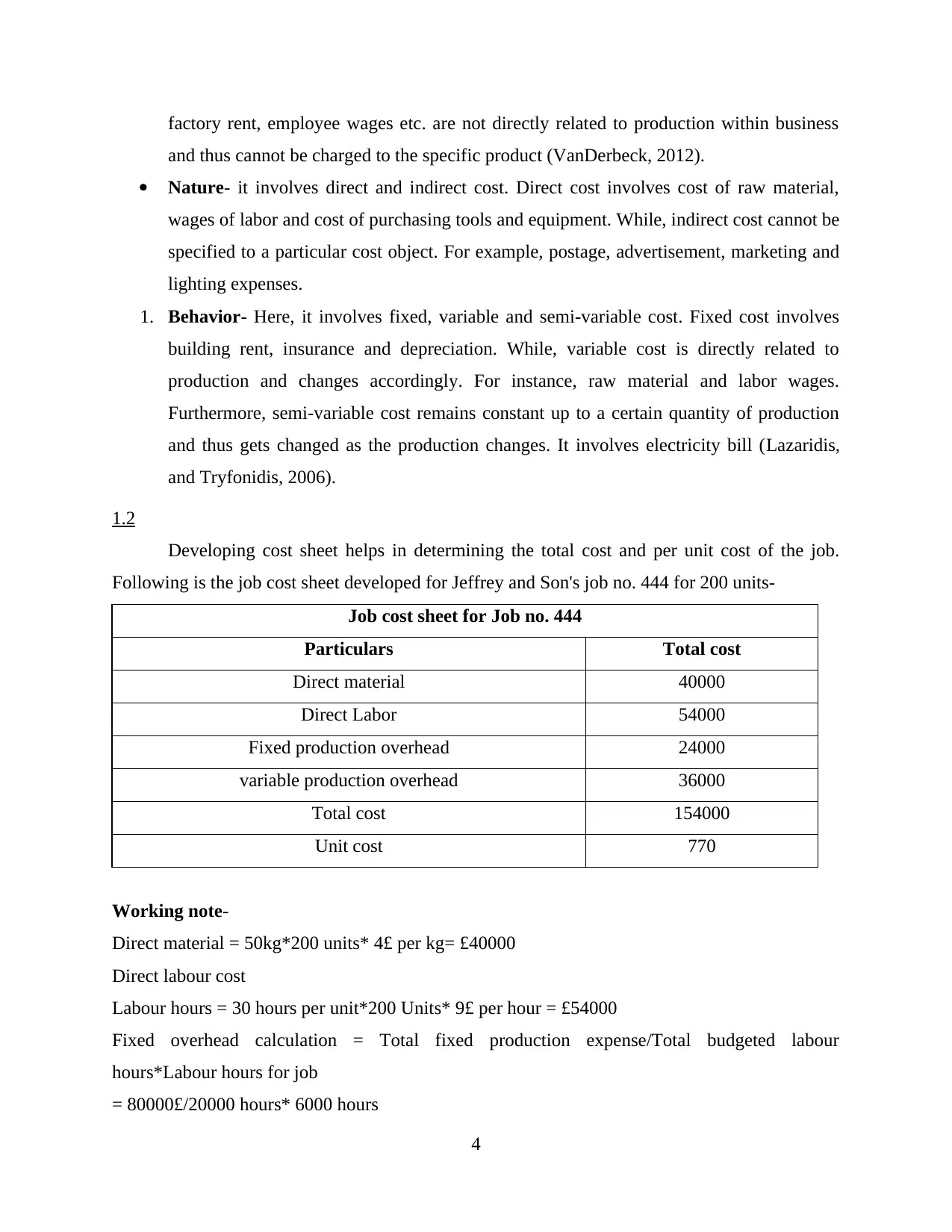
factory rent, employee wages etc. are not directly related to production within business
and thus cannot be charged to the specific product (VanDerbeck, 2012).
Nature- it involves direct and indirect cost. Direct cost involves cost of raw material,
wages of labor and cost of purchasing tools and equipment. While, indirect cost cannot be
specified to a particular cost object. For example, postage, advertisement, marketing and
lighting expenses.
1. Behavior- Here, it involves fixed, variable and semi-variable cost. Fixed cost involves
building rent, insurance and depreciation. While, variable cost is directly related to
production and changes accordingly. For instance, raw material and labor wages.
Furthermore, semi-variable cost remains constant up to a certain quantity of production
and thus gets changed as the production changes. It involves electricity bill (Lazaridis,
and Tryfonidis, 2006).
1.2
Developing cost sheet helps in determining the total cost and per unit cost of the job.
Following is the job cost sheet developed for Jeffrey and Son's job no. 444 for 200 units-
Job cost sheet for Job no. 444
Particulars Total cost
Direct material 40000
Direct Labor 54000
Fixed production overhead 24000
variable production overhead 36000
Total cost 154000
Unit cost 770
Working note-
Direct material = 50kg*200 units* 4£ per kg= £40000
Direct labour cost
Labour hours = 30 hours per unit*200 Units* 9£ per hour = £54000
Fixed overhead calculation = Total fixed production expense/Total budgeted labour
hours*Labour hours for job
= 80000£/20000 hours* 6000 hours
4
and thus cannot be charged to the specific product (VanDerbeck, 2012).
Nature- it involves direct and indirect cost. Direct cost involves cost of raw material,
wages of labor and cost of purchasing tools and equipment. While, indirect cost cannot be
specified to a particular cost object. For example, postage, advertisement, marketing and
lighting expenses.
1. Behavior- Here, it involves fixed, variable and semi-variable cost. Fixed cost involves
building rent, insurance and depreciation. While, variable cost is directly related to
production and changes accordingly. For instance, raw material and labor wages.
Furthermore, semi-variable cost remains constant up to a certain quantity of production
and thus gets changed as the production changes. It involves electricity bill (Lazaridis,
and Tryfonidis, 2006).
1.2
Developing cost sheet helps in determining the total cost and per unit cost of the job.
Following is the job cost sheet developed for Jeffrey and Son's job no. 444 for 200 units-
Job cost sheet for Job no. 444
Particulars Total cost
Direct material 40000
Direct Labor 54000
Fixed production overhead 24000
variable production overhead 36000
Total cost 154000
Unit cost 770
Working note-
Direct material = 50kg*200 units* 4£ per kg= £40000
Direct labour cost
Labour hours = 30 hours per unit*200 Units* 9£ per hour = £54000
Fixed overhead calculation = Total fixed production expense/Total budgeted labour
hours*Labour hours for job
= 80000£/20000 hours* 6000 hours
4
Paraphrase This Document
Need a fresh take? Get an instant paraphrase of this document with our AI Paraphraser
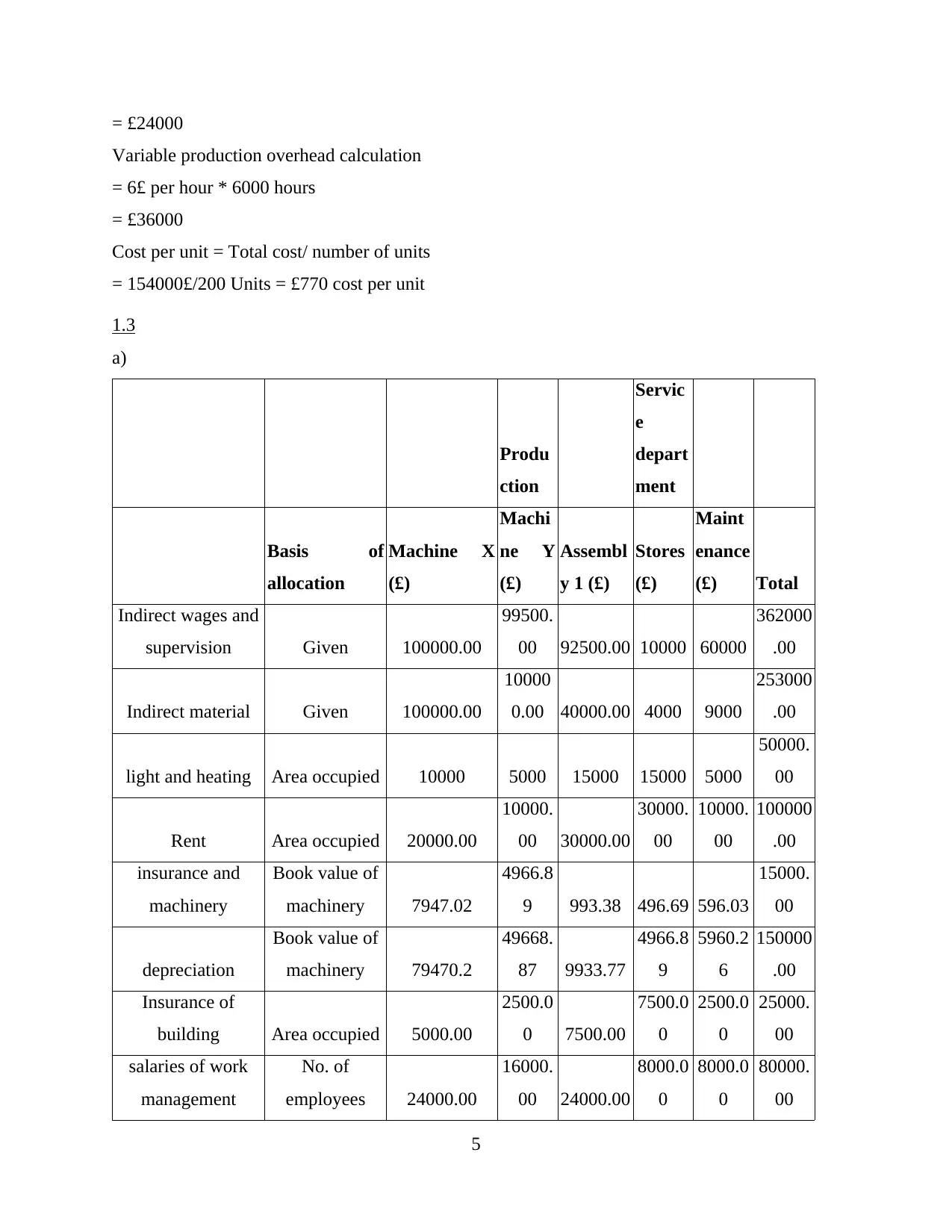
= £24000
Variable production overhead calculation
= 6£ per hour * 6000 hours
= £36000
Cost per unit = Total cost/ number of units
= 154000£/200 Units = £770 cost per unit
1.3
a)
Produ
ction
Servic
e
depart
ment
Basis of
allocation
Machine X
(£)
Machi
ne Y
(£)
Assembl
y 1 (£)
Stores
(£)
Maint
enance
(£) Total
Indirect wages and
supervision Given 100000.00
99500.
00 92500.00 10000 60000
362000
.00
Indirect material Given 100000.00
10000
0.00 40000.00 4000 9000
253000
.00
light and heating Area occupied 10000 5000 15000 15000 5000
50000.
00
Rent Area occupied 20000.00
10000.
00 30000.00
30000.
00
10000.
00
100000
.00
insurance and
machinery
Book value of
machinery 7947.02
4966.8
9 993.38 496.69 596.03
15000.
00
depreciation
Book value of
machinery 79470.2
49668.
87 9933.77
4966.8
9
5960.2
6
150000
.00
Insurance of
building Area occupied 5000.00
2500.0
0 7500.00
7500.0
0
2500.0
0
25000.
00
salaries of work
management
No. of
employees 24000.00
16000.
00 24000.00
8000.0
0
8000.0
0
80000.
00
5
Variable production overhead calculation
= 6£ per hour * 6000 hours
= £36000
Cost per unit = Total cost/ number of units
= 154000£/200 Units = £770 cost per unit
1.3
a)
Produ
ction
Servic
e
depart
ment
Basis of
allocation
Machine X
(£)
Machi
ne Y
(£)
Assembl
y 1 (£)
Stores
(£)
Maint
enance
(£) Total
Indirect wages and
supervision Given 100000.00
99500.
00 92500.00 10000 60000
362000
.00
Indirect material Given 100000.00
10000
0.00 40000.00 4000 9000
253000
.00
light and heating Area occupied 10000 5000 15000 15000 5000
50000.
00
Rent Area occupied 20000.00
10000.
00 30000.00
30000.
00
10000.
00
100000
.00
insurance and
machinery
Book value of
machinery 7947.02
4966.8
9 993.38 496.69 596.03
15000.
00
depreciation
Book value of
machinery 79470.2
49668.
87 9933.77
4966.8
9
5960.2
6
150000
.00
Insurance of
building Area occupied 5000.00
2500.0
0 7500.00
7500.0
0
2500.0
0
25000.
00
salaries of work
management
No. of
employees 24000.00
16000.
00 24000.00
8000.0
0
8000.0
0
80000.
00
5
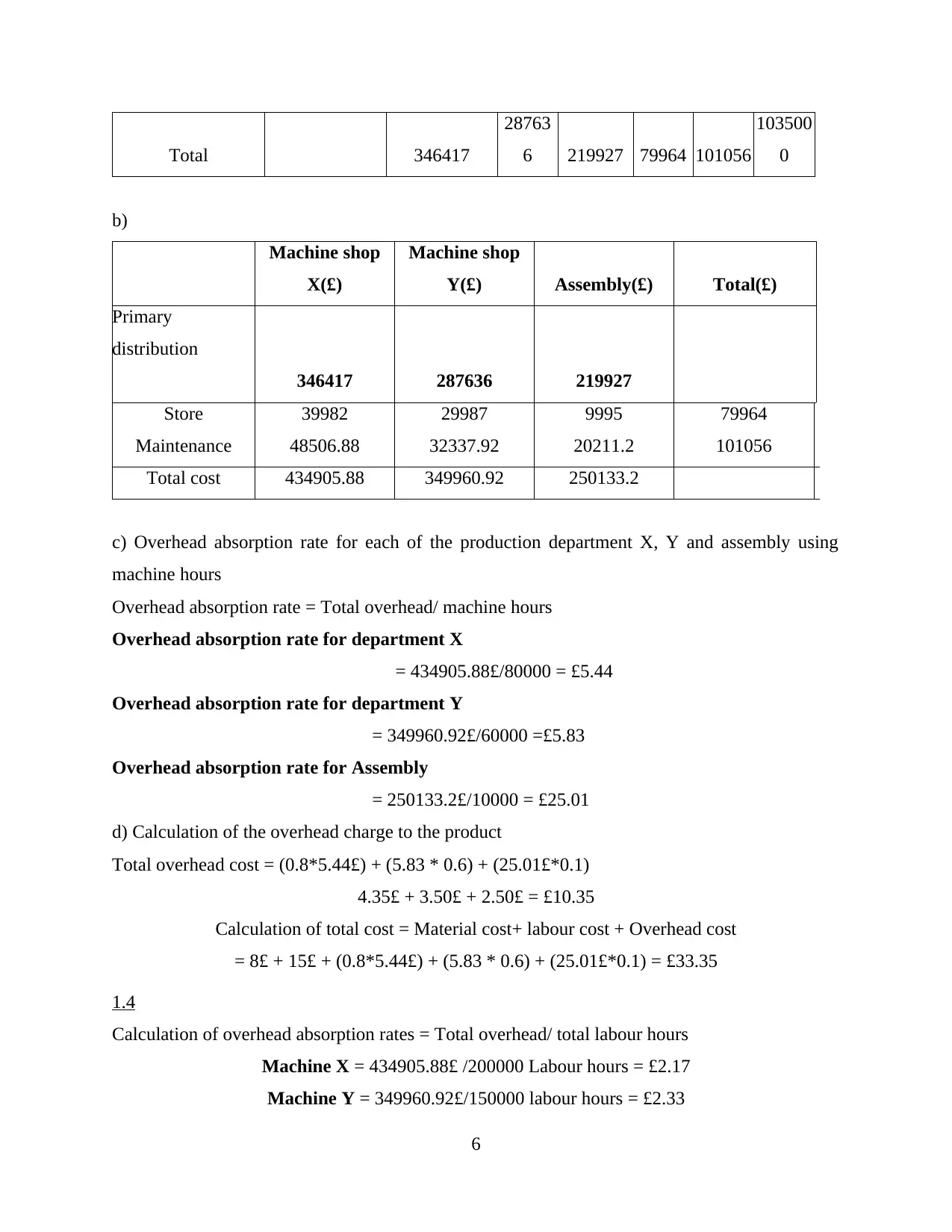
Total 346417
28763
6 219927 79964 101056
103500
0
b)
Machine shop
X(£)
Machine shop
Y(£) Assembly(£) Total(£)
Primary
distribution
346417 287636 219927
Store 39982 29987 9995 79964
Maintenance 48506.88 32337.92 20211.2 101056
Total cost 434905.88 349960.92 250133.2
c) Overhead absorption rate for each of the production department X, Y and assembly using
machine hours
Overhead absorption rate = Total overhead/ machine hours
Overhead absorption rate for department X
= 434905.88£/80000 = £5.44
Overhead absorption rate for department Y
= 349960.92£/60000 =£5.83
Overhead absorption rate for Assembly
= 250133.2£/10000 = £25.01
d) Calculation of the overhead charge to the product
Total overhead cost = (0.8*5.44£) + (5.83 * 0.6) + (25.01£*0.1)
4.35£ + 3.50£ + 2.50£ = £10.35
Calculation of total cost = Material cost+ labour cost + Overhead cost
= 8£ + 15£ + (0.8*5.44£) + (5.83 * 0.6) + (25.01£*0.1) = £33.35
1.4
Calculation of overhead absorption rates = Total overhead/ total labour hours
Machine X = 434905.88£ /200000 Labour hours = £2.17
Machine Y = 349960.92£/150000 labour hours = £2.33
6
28763
6 219927 79964 101056
103500
0
b)
Machine shop
X(£)
Machine shop
Y(£) Assembly(£) Total(£)
Primary
distribution
346417 287636 219927
Store 39982 29987 9995 79964
Maintenance 48506.88 32337.92 20211.2 101056
Total cost 434905.88 349960.92 250133.2
c) Overhead absorption rate for each of the production department X, Y and assembly using
machine hours
Overhead absorption rate = Total overhead/ machine hours
Overhead absorption rate for department X
= 434905.88£/80000 = £5.44
Overhead absorption rate for department Y
= 349960.92£/60000 =£5.83
Overhead absorption rate for Assembly
= 250133.2£/10000 = £25.01
d) Calculation of the overhead charge to the product
Total overhead cost = (0.8*5.44£) + (5.83 * 0.6) + (25.01£*0.1)
4.35£ + 3.50£ + 2.50£ = £10.35
Calculation of total cost = Material cost+ labour cost + Overhead cost
= 8£ + 15£ + (0.8*5.44£) + (5.83 * 0.6) + (25.01£*0.1) = £33.35
1.4
Calculation of overhead absorption rates = Total overhead/ total labour hours
Machine X = 434905.88£ /200000 Labour hours = £2.17
Machine Y = 349960.92£/150000 labour hours = £2.33
6
⊘ This is a preview!⊘
Do you want full access?
Subscribe today to unlock all pages.

Trusted by 1+ million students worldwide

Assembly = 250133.2£/200000 labour hours = £1.25
Total overhead cost = (2.17£*2) + (1.5*2.33£) + (1*1.25£)
4.34£ + 3.50£ + 1.25£ = £9.09
Total product cost = Material + Labour + Overhead
= 8£ + 15£ + 9.09£ = £32.09
Differences of the unit cost- Through using the machine hours it can be assessed that the
overhead cost for Machine X, Machine Y and Assembly are £5.44, £5.83 and £25.01. While,
undertaking labor hour operation basis overhead cost for all the production departments are
£2.14, £2.3 and £1.25. On the other hand, total overhead cost charged to the product under the
machine hour and labor hour basis are £10.35 and £9.09. Therefore, it can be assessed that the
total product cost is £33.35 and £32.09. However, it is high in case of using machine hour on an
appropriate basis. For instance, at the time when Jeffrey and Sons uses labor hour basis the
product cost get changed to £32.09 which is comparatively lower than the machine hour basis.
Therefore, it can be stated that this is comparatively a good basis of apportionment.
TASK 2
2.1
According to the scenario, cost sheet has been developed for Jeffrey and Sons Ltd. i.e. for
1900 units in regard to identify the total cost and cost per unit. Also, variance analysis is required
to be done through assessing the difference among the actual figures and budgeted.
Budgeted Output ( 2000 Units) Actual Output ( 1900 Units)
Particular Per unit cost Total cost Per unit cost Total cost
Material 12 24000 12 22800
Labour 9 18000 10 19000
Fixed Overhead 15000 15000
Electricity 8000 7625
Maintenance 5000 4800
Total 35 70000 36.43 69225
7
Total overhead cost = (2.17£*2) + (1.5*2.33£) + (1*1.25£)
4.34£ + 3.50£ + 1.25£ = £9.09
Total product cost = Material + Labour + Overhead
= 8£ + 15£ + 9.09£ = £32.09
Differences of the unit cost- Through using the machine hours it can be assessed that the
overhead cost for Machine X, Machine Y and Assembly are £5.44, £5.83 and £25.01. While,
undertaking labor hour operation basis overhead cost for all the production departments are
£2.14, £2.3 and £1.25. On the other hand, total overhead cost charged to the product under the
machine hour and labor hour basis are £10.35 and £9.09. Therefore, it can be assessed that the
total product cost is £33.35 and £32.09. However, it is high in case of using machine hour on an
appropriate basis. For instance, at the time when Jeffrey and Sons uses labor hour basis the
product cost get changed to £32.09 which is comparatively lower than the machine hour basis.
Therefore, it can be stated that this is comparatively a good basis of apportionment.
TASK 2
2.1
According to the scenario, cost sheet has been developed for Jeffrey and Sons Ltd. i.e. for
1900 units in regard to identify the total cost and cost per unit. Also, variance analysis is required
to be done through assessing the difference among the actual figures and budgeted.
Budgeted Output ( 2000 Units) Actual Output ( 1900 Units)
Particular Per unit cost Total cost Per unit cost Total cost
Material 12 24000 12 22800
Labour 9 18000 10 19000
Fixed Overhead 15000 15000
Electricity 8000 7625
Maintenance 5000 4800
Total 35 70000 36.43 69225
7
Paraphrase This Document
Need a fresh take? Get an instant paraphrase of this document with our AI Paraphraser

Necessary Working Note:
Material cost = 24000£/2000Units *1900 units = £22800
Labour cost 10£ per unit * 1900 Units = £19000
Electricity is semi variable cost
Variable cost per unit = 8000£ - 5000£/2000 Units -1200 Units
= 3000£/800 Units = 3.75 per unit
Fixed charges = 8000£ - (3.75£*2000 Units) = £500
Variable electricity charges = 3.75£*1900 Units
= £7125
Total electricity charges = 7125£ + 500£ = £7625
Maintenance cost = 5000£ - (1000£/500 units*100 Units) = £4800
Cost per unit = 69225£/1900 Units = £36.43
Variance Analysis: The variances are calculates as under:
Particular Budgeted cost Actual cost Variance
Material 24000 22800 1200
Labour 18000 19000 -1000
Fixed Overhead 15000 15000 0
Electricity 8000 7625 375
Maintenance 5000 4800 200
Total 70000 69225 775
Evaluation- Material variance helps in assessing that the company is required to bear lower the
cost as compared to the budgeted cost. Therefore, the material price variance is 0 as the price of
material remains the same i.e. £12 per unit. Also, the labor cost has been enhanced due to higher
labor rate to £10 per unit. While, the cost of electricity is declining to £7625. Hence, it can be
articulated that labor cost variance, material cost variance and labor rate variance influences in
negative aspect to the firm. Also, it influences the profitability of firm up to a great extent.
Therefore, it is crucial for the management to identify different solutions so that they can
minimize all these negative aspects (Peasnell, Pope and Young, 2005).
8
Material cost = 24000£/2000Units *1900 units = £22800
Labour cost 10£ per unit * 1900 Units = £19000
Electricity is semi variable cost
Variable cost per unit = 8000£ - 5000£/2000 Units -1200 Units
= 3000£/800 Units = 3.75 per unit
Fixed charges = 8000£ - (3.75£*2000 Units) = £500
Variable electricity charges = 3.75£*1900 Units
= £7125
Total electricity charges = 7125£ + 500£ = £7625
Maintenance cost = 5000£ - (1000£/500 units*100 Units) = £4800
Cost per unit = 69225£/1900 Units = £36.43
Variance Analysis: The variances are calculates as under:
Particular Budgeted cost Actual cost Variance
Material 24000 22800 1200
Labour 18000 19000 -1000
Fixed Overhead 15000 15000 0
Electricity 8000 7625 375
Maintenance 5000 4800 200
Total 70000 69225 775
Evaluation- Material variance helps in assessing that the company is required to bear lower the
cost as compared to the budgeted cost. Therefore, the material price variance is 0 as the price of
material remains the same i.e. £12 per unit. Also, the labor cost has been enhanced due to higher
labor rate to £10 per unit. While, the cost of electricity is declining to £7625. Hence, it can be
articulated that labor cost variance, material cost variance and labor rate variance influences in
negative aspect to the firm. Also, it influences the profitability of firm up to a great extent.
Therefore, it is crucial for the management to identify different solutions so that they can
minimize all these negative aspects (Peasnell, Pope and Young, 2005).
8
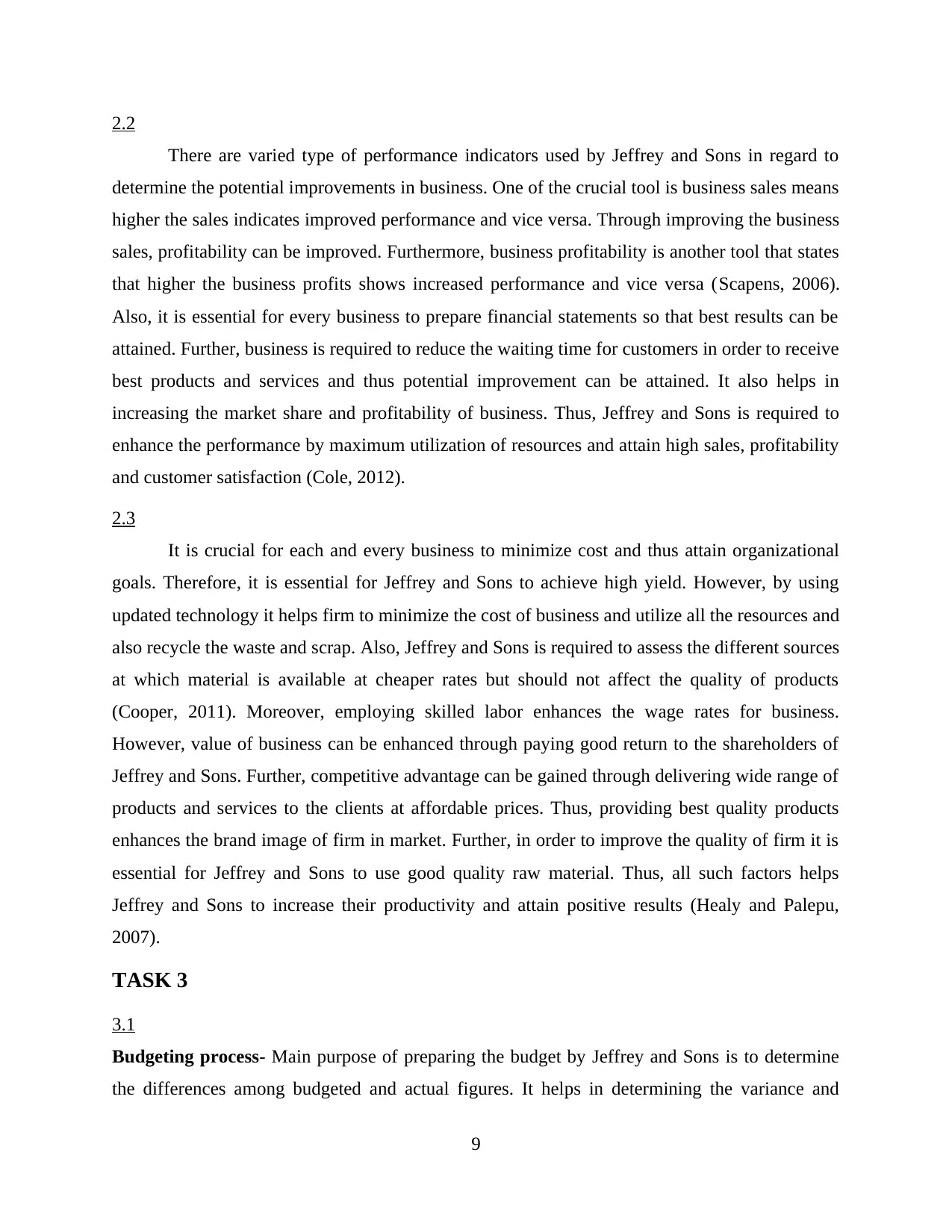
2.2
There are varied type of performance indicators used by Jeffrey and Sons in regard to
determine the potential improvements in business. One of the crucial tool is business sales means
higher the sales indicates improved performance and vice versa. Through improving the business
sales, profitability can be improved. Furthermore, business profitability is another tool that states
that higher the business profits shows increased performance and vice versa (Scapens, 2006).
Also, it is essential for every business to prepare financial statements so that best results can be
attained. Further, business is required to reduce the waiting time for customers in order to receive
best products and services and thus potential improvement can be attained. It also helps in
increasing the market share and profitability of business. Thus, Jeffrey and Sons is required to
enhance the performance by maximum utilization of resources and attain high sales, profitability
and customer satisfaction (Cole, 2012).
2.3
It is crucial for each and every business to minimize cost and thus attain organizational
goals. Therefore, it is essential for Jeffrey and Sons to achieve high yield. However, by using
updated technology it helps firm to minimize the cost of business and utilize all the resources and
also recycle the waste and scrap. Also, Jeffrey and Sons is required to assess the different sources
at which material is available at cheaper rates but should not affect the quality of products
(Cooper, 2011). Moreover, employing skilled labor enhances the wage rates for business.
However, value of business can be enhanced through paying good return to the shareholders of
Jeffrey and Sons. Further, competitive advantage can be gained through delivering wide range of
products and services to the clients at affordable prices. Thus, providing best quality products
enhances the brand image of firm in market. Further, in order to improve the quality of firm it is
essential for Jeffrey and Sons to use good quality raw material. Thus, all such factors helps
Jeffrey and Sons to increase their productivity and attain positive results (Healy and Palepu,
2007).
TASK 3
3.1
Budgeting process- Main purpose of preparing the budget by Jeffrey and Sons is to determine
the differences among budgeted and actual figures. It helps in determining the variance and
9
There are varied type of performance indicators used by Jeffrey and Sons in regard to
determine the potential improvements in business. One of the crucial tool is business sales means
higher the sales indicates improved performance and vice versa. Through improving the business
sales, profitability can be improved. Furthermore, business profitability is another tool that states
that higher the business profits shows increased performance and vice versa (Scapens, 2006).
Also, it is essential for every business to prepare financial statements so that best results can be
attained. Further, business is required to reduce the waiting time for customers in order to receive
best products and services and thus potential improvement can be attained. It also helps in
increasing the market share and profitability of business. Thus, Jeffrey and Sons is required to
enhance the performance by maximum utilization of resources and attain high sales, profitability
and customer satisfaction (Cole, 2012).
2.3
It is crucial for each and every business to minimize cost and thus attain organizational
goals. Therefore, it is essential for Jeffrey and Sons to achieve high yield. However, by using
updated technology it helps firm to minimize the cost of business and utilize all the resources and
also recycle the waste and scrap. Also, Jeffrey and Sons is required to assess the different sources
at which material is available at cheaper rates but should not affect the quality of products
(Cooper, 2011). Moreover, employing skilled labor enhances the wage rates for business.
However, value of business can be enhanced through paying good return to the shareholders of
Jeffrey and Sons. Further, competitive advantage can be gained through delivering wide range of
products and services to the clients at affordable prices. Thus, providing best quality products
enhances the brand image of firm in market. Further, in order to improve the quality of firm it is
essential for Jeffrey and Sons to use good quality raw material. Thus, all such factors helps
Jeffrey and Sons to increase their productivity and attain positive results (Healy and Palepu,
2007).
TASK 3
3.1
Budgeting process- Main purpose of preparing the budget by Jeffrey and Sons is to determine
the differences among budgeted and actual figures. It helps in determining the variance and
9
⊘ This is a preview!⊘
Do you want full access?
Subscribe today to unlock all pages.

Trusted by 1+ million students worldwide
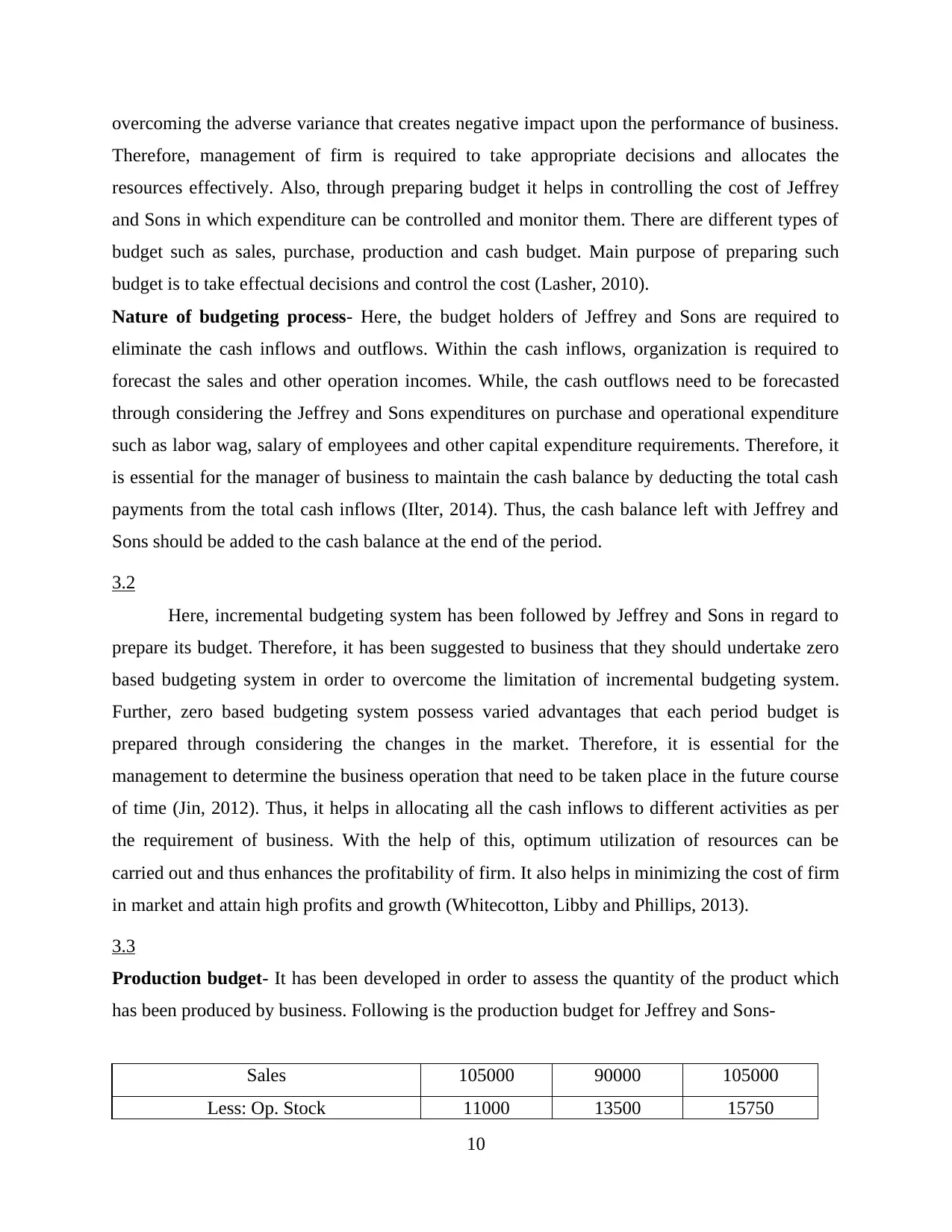
overcoming the adverse variance that creates negative impact upon the performance of business.
Therefore, management of firm is required to take appropriate decisions and allocates the
resources effectively. Also, through preparing budget it helps in controlling the cost of Jeffrey
and Sons in which expenditure can be controlled and monitor them. There are different types of
budget such as sales, purchase, production and cash budget. Main purpose of preparing such
budget is to take effectual decisions and control the cost (Lasher, 2010).
Nature of budgeting process- Here, the budget holders of Jeffrey and Sons are required to
eliminate the cash inflows and outflows. Within the cash inflows, organization is required to
forecast the sales and other operation incomes. While, the cash outflows need to be forecasted
through considering the Jeffrey and Sons expenditures on purchase and operational expenditure
such as labor wag, salary of employees and other capital expenditure requirements. Therefore, it
is essential for the manager of business to maintain the cash balance by deducting the total cash
payments from the total cash inflows (Ilter, 2014). Thus, the cash balance left with Jeffrey and
Sons should be added to the cash balance at the end of the period.
3.2
Here, incremental budgeting system has been followed by Jeffrey and Sons in regard to
prepare its budget. Therefore, it has been suggested to business that they should undertake zero
based budgeting system in order to overcome the limitation of incremental budgeting system.
Further, zero based budgeting system possess varied advantages that each period budget is
prepared through considering the changes in the market. Therefore, it is essential for the
management to determine the business operation that need to be taken place in the future course
of time (Jin, 2012). Thus, it helps in allocating all the cash inflows to different activities as per
the requirement of business. With the help of this, optimum utilization of resources can be
carried out and thus enhances the profitability of firm. It also helps in minimizing the cost of firm
in market and attain high profits and growth (Whitecotton, Libby and Phillips, 2013).
3.3
Production budget- It has been developed in order to assess the quantity of the product which
has been produced by business. Following is the production budget for Jeffrey and Sons-
Sales 105000 90000 105000
Less: Op. Stock 11000 13500 15750
10
Therefore, management of firm is required to take appropriate decisions and allocates the
resources effectively. Also, through preparing budget it helps in controlling the cost of Jeffrey
and Sons in which expenditure can be controlled and monitor them. There are different types of
budget such as sales, purchase, production and cash budget. Main purpose of preparing such
budget is to take effectual decisions and control the cost (Lasher, 2010).
Nature of budgeting process- Here, the budget holders of Jeffrey and Sons are required to
eliminate the cash inflows and outflows. Within the cash inflows, organization is required to
forecast the sales and other operation incomes. While, the cash outflows need to be forecasted
through considering the Jeffrey and Sons expenditures on purchase and operational expenditure
such as labor wag, salary of employees and other capital expenditure requirements. Therefore, it
is essential for the manager of business to maintain the cash balance by deducting the total cash
payments from the total cash inflows (Ilter, 2014). Thus, the cash balance left with Jeffrey and
Sons should be added to the cash balance at the end of the period.
3.2
Here, incremental budgeting system has been followed by Jeffrey and Sons in regard to
prepare its budget. Therefore, it has been suggested to business that they should undertake zero
based budgeting system in order to overcome the limitation of incremental budgeting system.
Further, zero based budgeting system possess varied advantages that each period budget is
prepared through considering the changes in the market. Therefore, it is essential for the
management to determine the business operation that need to be taken place in the future course
of time (Jin, 2012). Thus, it helps in allocating all the cash inflows to different activities as per
the requirement of business. With the help of this, optimum utilization of resources can be
carried out and thus enhances the profitability of firm. It also helps in minimizing the cost of firm
in market and attain high profits and growth (Whitecotton, Libby and Phillips, 2013).
3.3
Production budget- It has been developed in order to assess the quantity of the product which
has been produced by business. Following is the production budget for Jeffrey and Sons-
Sales 105000 90000 105000
Less: Op. Stock 11000 13500 15750
10
Paraphrase This Document
Need a fresh take? Get an instant paraphrase of this document with our AI Paraphraser

94000 76500 89250
Add: Closing stock 13500 15750 16500
Total Production 107500 92250 105750
Working Note:
Closing stock = It is required equal to 15% of the next year sales
July = 90000 Units*15% = 13500 Units
August: 105000Units*15% = 15750
September: 110000Units *15% = 16500 Units
Material Purchase Budget: It is developed in regard to assess the quantity of material which is
required to produce the desired quantity of finished products.
Material Require (2 per kg) 215000 184500 211500
Less- Opening stock 52000 45000 52500
Total 163000 139500 159000
Add- Closing stock 46125 52875 54250
Purchase 209125 191250 212875
Working note:
Material requirement = Production * material required per unit
July = 107500 * 2 = 215000 Kg
August = 92250 * 2 = 184500 kg
September = 105750 * 2 = 211500 kg
Closing Stock = It is required to 25% of the next month requirements.
July = 92250 Units*2 Kg*25% = 46125 Kg
August = 105750 units*2kg *25% = 52875 Kg
September = 108500 Units*2Kg*25% = 54250 Kg
3.4
Cash budget- It can be stated that developing cash budget helps in combining all the
estimated or forecasted cash inflows and outflows for the future course of action. Following
is the cash budget for Jeffrey and Sons-
11
Add: Closing stock 13500 15750 16500
Total Production 107500 92250 105750
Working Note:
Closing stock = It is required equal to 15% of the next year sales
July = 90000 Units*15% = 13500 Units
August: 105000Units*15% = 15750
September: 110000Units *15% = 16500 Units
Material Purchase Budget: It is developed in regard to assess the quantity of material which is
required to produce the desired quantity of finished products.
Material Require (2 per kg) 215000 184500 211500
Less- Opening stock 52000 45000 52500
Total 163000 139500 159000
Add- Closing stock 46125 52875 54250
Purchase 209125 191250 212875
Working note:
Material requirement = Production * material required per unit
July = 107500 * 2 = 215000 Kg
August = 92250 * 2 = 184500 kg
September = 105750 * 2 = 211500 kg
Closing Stock = It is required to 25% of the next month requirements.
July = 92250 Units*2 Kg*25% = 46125 Kg
August = 105750 units*2kg *25% = 52875 Kg
September = 108500 Units*2Kg*25% = 54250 Kg
3.4
Cash budget- It can be stated that developing cash budget helps in combining all the
estimated or forecasted cash inflows and outflows for the future course of action. Following
is the cash budget for Jeffrey and Sons-
11
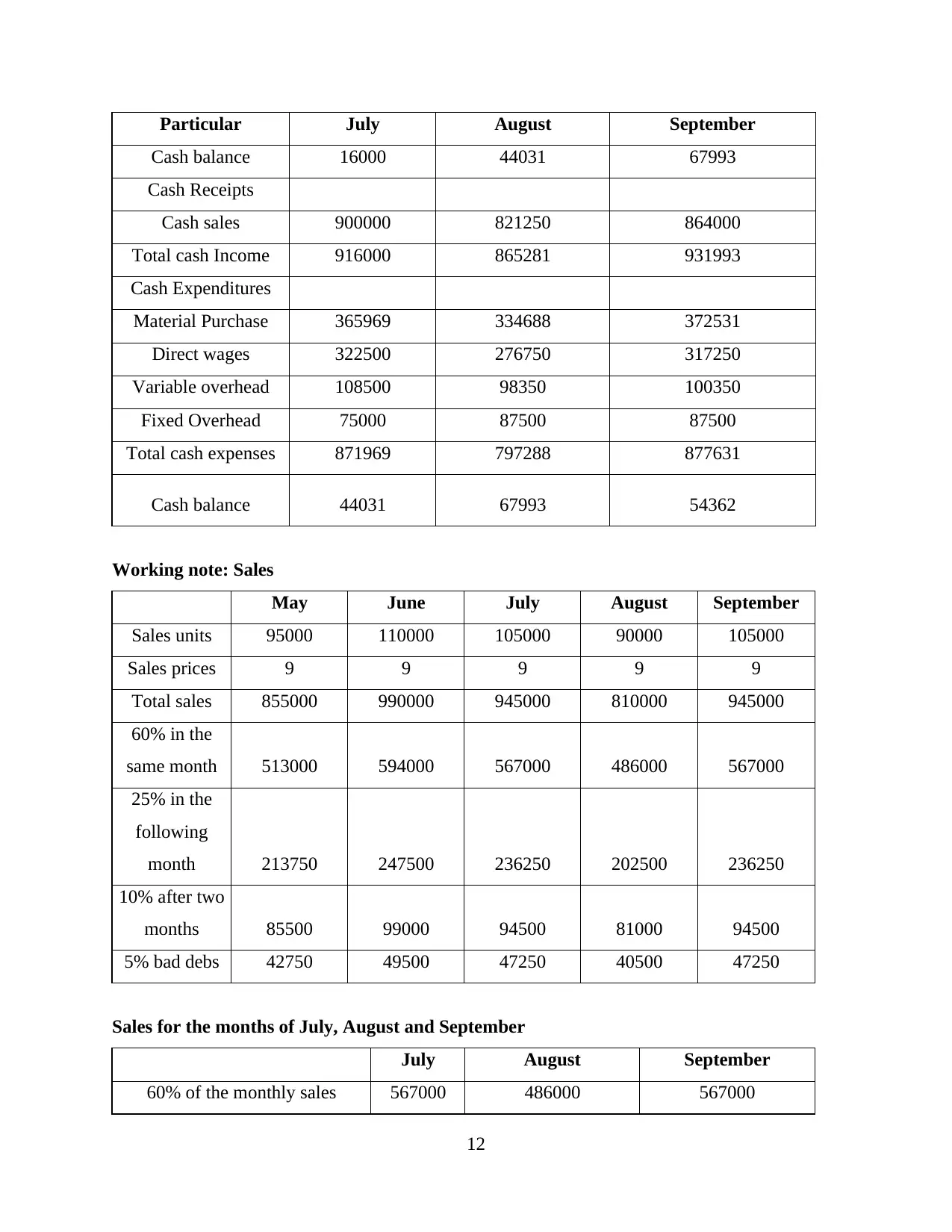
Particular July August September
Cash balance 16000 44031 67993
Cash Receipts
Cash sales 900000 821250 864000
Total cash Income 916000 865281 931993
Cash Expenditures
Material Purchase 365969 334688 372531
Direct wages 322500 276750 317250
Variable overhead 108500 98350 100350
Fixed Overhead 75000 87500 87500
Total cash expenses 871969 797288 877631
Cash balance 44031 67993 54362
Working note: Sales
May June July August September
Sales units 95000 110000 105000 90000 105000
Sales prices 9 9 9 9 9
Total sales 855000 990000 945000 810000 945000
60% in the
same month 513000 594000 567000 486000 567000
25% in the
following
month 213750 247500 236250 202500 236250
10% after two
months 85500 99000 94500 81000 94500
5% bad debs 42750 49500 47250 40500 47250
Sales for the months of July, August and September
July August September
60% of the monthly sales 567000 486000 567000
12
Cash balance 16000 44031 67993
Cash Receipts
Cash sales 900000 821250 864000
Total cash Income 916000 865281 931993
Cash Expenditures
Material Purchase 365969 334688 372531
Direct wages 322500 276750 317250
Variable overhead 108500 98350 100350
Fixed Overhead 75000 87500 87500
Total cash expenses 871969 797288 877631
Cash balance 44031 67993 54362
Working note: Sales
May June July August September
Sales units 95000 110000 105000 90000 105000
Sales prices 9 9 9 9 9
Total sales 855000 990000 945000 810000 945000
60% in the
same month 513000 594000 567000 486000 567000
25% in the
following
month 213750 247500 236250 202500 236250
10% after two
months 85500 99000 94500 81000 94500
5% bad debs 42750 49500 47250 40500 47250
Sales for the months of July, August and September
July August September
60% of the monthly sales 567000 486000 567000
12
⊘ This is a preview!⊘
Do you want full access?
Subscribe today to unlock all pages.

Trusted by 1+ million students worldwide
1 out of 18
Related Documents
Your All-in-One AI-Powered Toolkit for Academic Success.
+13062052269
info@desklib.com
Available 24*7 on WhatsApp / Email
![[object Object]](/_next/static/media/star-bottom.7253800d.svg)
Unlock your academic potential
Copyright © 2020–2025 A2Z Services. All Rights Reserved. Developed and managed by ZUCOL.





